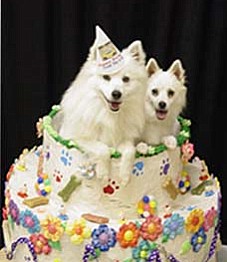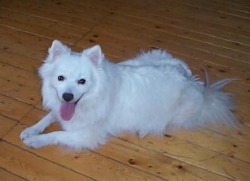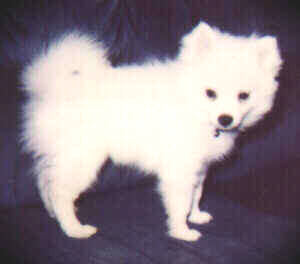|
|
Want
to Adopt an Eskie, please read on...

Please
do not rush into this decision. By adopting a Miniature American Eskimo
dog you are making a commitment of 15 years or more. We want to place our
puppies only in suitable homes. Please read the following and check out
the links on our links page as well. You can learn a lot and prepare
yourself, your family and your home to make the adoption a success and as
least stressful on your new puppy as possible.

Excerpts from:
"American Eskimo Dogs, A Complete Pet Owner's Manual"
by D. Caroline Coile, Ph.D.
An excellent resource, as are so many other books, for anyone looking at
or planning on adding an American Eskimo to their family.
"Maybe it's been in the back of your mind for months. Maybe it just
popped in one day. However it got there, the thought just won't go away:
you want a dog. A cuddly, playful, beautiful, loyal obedient,
protective, wonderful dog that will make Lassie and Rin-Tin-Tin look
like canine underachievers. And you want it now. You want to get in the
car and head to Pups-R-Us and bring your bundle of fuzzy love right
home. But have you really thought this through?"
"First, can you make a commitment to this dog for the next 10 to 15
years of your life?... "
"Don't get a dog on a trial basis. If you tire of your dog and think it
won't be bothered when you cast it aside, think again...."
"Can you make the financial commitment of adding a new family member?
The cost of the dog is the least of your worries (and actually,
considering the number of years you will have it, a bargain). But food,
equipment, boarding, and vet bills can be high. Call several
veterinarians' offices in your area and ask the prices for office
visits, a series of puppy vaccinations, de-worming, yearly checkups,
neutering or spaying, emergency clinic visits, and monthly heartworm
prevention...."
"Does everyone in the family want a dog? Now is not the time to be
polite and hold your tongue. An unwelcome dog is and unwelcome guest,
and neither it nor the resentful family member should have to live
together. Don't get a dog just for the children. No matter how sincere
the promises to take care of the puppy might be at the time, Mom or Dad
will ultimately end up doing most of the work. ..."
"Think about why you really want a dog. Companionship? Hunting?
Protection? Showing? A way to meet people? Think even more about what
you don't want in a dog. Giant size? Shedding? Aggressiveness? Shyness?
Don't choose a breed because your neighbor has one, or it was the star
of a recent movie, or it's the current rage, or just because it looks
neat. Carefully decide what attributes you want in a dog, and what you
don't want; with over 150 recognized breeds in the United States alone,
there's very likely a breed out there with your name on it. Maybe it's
the American Eskimo dog."
"Most people are initially attracted to a breed because of its looks,
and the stunning white Eskie is no exception. But far too often dogs are
acquired with the idea that all breeds act the same. They don't. ..."
"So what is in an Eskie's genes? There are individual differences, but
the typical Eskie is an alert, bright, quick-witted dog, wonderfully
obedient but sometimes playfully mischievous. The Eskie is loving,
demonstrative without being fawning, and is extremely loyal to its
family. The Eskie thinks of itself as a family member and expects to be
treated like one. Do not expect an Eskie to be happy if banished to the
yard. The Eskie is an excellent watchdog, but does not have the physical
attributes to be an intimidating protection dog. Sometimes barking can
become excessive. Although not one-person dogs, Eskies do take a while
to warm up to strangers. They must be well socialized as youngsters, or
this natural wariness can be expressed as shyness and even fear biting.
And although Eskies may occasionally be headstrong, in general they are
a "soft" breed and tend to be extremely sensitive to harsh works or
corrections. In a survey of Eskimo dog owners, barking and digging were
listed as the most common problem behaviors, followed by shyness and
hyperactivity. Biting, destructive behavior, escaping, and dog fighting
were rarely a problem. Some poorly bred Eskies can have nasty
temperaments, so you should select your particular Eskie with great
care."
"Keeping the Eskie's coat gleaming and full and white is not as daunting
a task as it might first appear. Its coat texture is such that dirt does
not cling, and even mud will fall from the coat as it dries (of course,
this may be in your house!). This texture, coupled with a relative lack
of oiliness, also tends to be resistant to easy matting, and best of
all, the Eskie is virtually free of doggy odor! It is also a good breed
for allergic dog owners, as the Eskie sheds minimal dog dander."

Puppies are available occasionally... Phone or e-mail to be put on a
waiting list for the next litter... or come back soon.
Phone: (250) 774-6592
or
E-mail:
polar_pups@yahoo.ca
|




